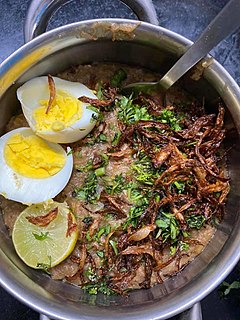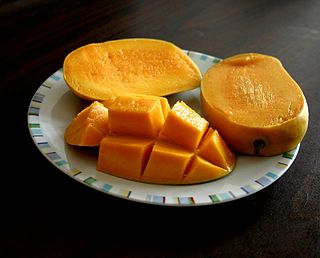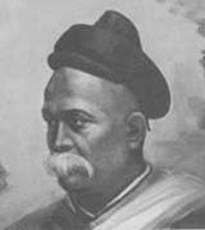
A geographical indication (GI) is a name or sign used on products which corresponds to a specific geographical location or origin. The use of a geographical indication, as an indication of the product's source, acts as a certification that the product possesses certain qualities, is made according to traditional methods, or enjoys a good reputation due to its geographical origin.
Cultural appropriation is the unacknowledged or inappropriate adoption of an element or elements of one culture or identity by members of another culture or identity. This can be controversial when members of a dominant culture appropriate from minority cultures.

Rasgulla, also known as Rosogolla,Rosgola, or Rasagola is a South Asian syrupy dessert popular in the Indian subcontinent and regions with South Asian diaspora. It is made from ball-shaped dumplings of chhena and semolina dough, cooked in light sugar syrup made of sugar. This is done until the syrup permeates the dumplings.

A Banarasi sari is a sari made in Varanasi, an ancient city which is also called Benares (Banaras). The saris are among the finest saris in India and are known for their gold and silver brocade or zari, fine silk and opulent embroidery. The saris are made of finely woven silk and are decorated with intricate design, and, because of these engravings, are relatively heavy.
The Office of the Controller General of Patents, Designs and Trade Marks(CGPDTM) generally known as the Indian Patent Office, is an agency under the Department for Promotion of Industry and Internal Trade which administers the Indian law of Patents, Designs and Trade Marks.

Hyderabadi haleem is a type of haleem popular in the Indian city of Hyderabad. Haleem is a stew composed of meat, lentils and pounded wheat made into a thick paste. It is originally an Arabic dish and was introduced to the Hyderabad State by the Chaush people during the rule of the Nizams. Local traditional spices helped a unique Hyderabadi haleem evolve, which became popular among the native Hyderabadis by the 19th century.

Kolhapuri chappals are Indian hand-crafted leather slippers that are locally tanned using vegetable dyes. Kolhapuri Chappals or Kolhapuris as they are commonly referred to are a style of open-toed, T-strap sandal.
Pheta is the Marathi name for the distinctive traditional turban worn in Maharashtra, India.

Pagri, sometimes also transliterated as pagari, is the term for turban used in the Indian subcontinent. It specifically refers to a headdress that is worn by men and women, which needs to be manually tied. Other names include sapho.

Bikaneri bhujia, often simply called bhujia, is a popular crispy snack prepared by using moth beans and besan and spices, originating from Bikaner, a city in the western state of Rajasthan in India. Light yellow in colour, it has become not just a characteristic product of Bikaner, but also a generic name.

Sanjai Gandhi is an attorney at law specializing at intellectual property rights. Gandhi had been instrumental in getting protection under Geographical Indication Act, 1999 for more than 15 Geographical indications (GI) for the state of Tamil Nadu, India. The products for which IPR attorney Sanjai Gandhi has obtained GI protection are: Kancheepuram Silk Sarees, Bhavani Jamukkalam (bedsheet), Madurai Sungudi Saree, Salem White Silk, Kovai Kora Cotton, Arni Silk, Thanjavur Paintings, Thanjavur Dancing Doll, Ethomozhi Tall Coconut of Kanyakumari district and Tangalia Shawl of Gujarat, Thanjavur Veenai, Mahabalipuram Stone Sculpture, Thirubuvanam Silk Sarees, Dindigul Locks, Srivilliputtur Palkova, Kandangi Saree, Arumbavur Wood Carving, Thanjavur Pith Work.
Venkatagiri Sari is a sari style woven in Venkatagiri of Nellore district in the Indian state of Andhra Pradesh. It was registered as one of the geographical indication from Andhra Pradesh by Geographical Indications of Goods Act, 1999. Venkatagiri saris are known for their fine weaving. These style of saris can also be found in the villages of Sengunthapuram, Variyankaval, Elaiyur, Kallathur, Andimadam and Marudhur villages.
East India Leather is an Indian vegetable-tanned leather produced by the tanneries in Trichy and Dindigul in Tamil Nadu.

Pedana Kalamkari also known as Machilipatnam style of Kalamkari work which involves vegetable dyed block-painting of a fabric. it is produced at Pedana a nearby town of Machilipatnam in Krishna district of the Indian state of Andhra Pradesh. It was registered as one of the geographical indication from Andhra Pradesh under handicraft goods by Geographical Indications of Goods Act, 1999.
Kovai Cora cotton or Kovai Kora cotton is a type of saree made in the Coimbatore region in Tamil Nadu, India. It has been recognized as a Geographical indication by the Government of India in 2014–15. The Devanga community are pioneers in weaving Kovai Kora cotton saris. 82 Weaver cooperative Societies in Coimbatore, Tiruppur and Erode are authorised to sell Kovai Kora cotton saris.
The Geographical Indications of Goods Act, 1999 is a sui generis Act of the Parliament of India for protection of geographical indications in India. India, as a member of the World Trade Organization (WTO), enacted the Act to comply with the Agreement on Trade-Related Aspects of Intellectual Property Rights. The GI tag ensures that only those registered as authorised users are allowed to use the popular product name. Darjeeling tea became the first GI tagged product in India, in 2004–05, since then 370 goods had been added to the list as of August 2020.
This word explains the characteristics related to the Indian city Pune. Puneri word is referred in following areas.

Kangra tea is a tea from the Kangra district in Himachal Pradesh, India. Both black tea and green tea have been produced in the Kangra Valley since the mid-19th century. Kangra tea was given the Geographical Indication status in 2005.

The 'Gir Kesar' mango, also called Kesar, is a mango cultivar grown in the foothills of Girnar in Gujarat, western India. The mango is known for its bright orange colored pulp and was given the geographical indication status in 2011. The biggest market of Gir Kesar is in Talala Gir known as a Mango Market Yard.












